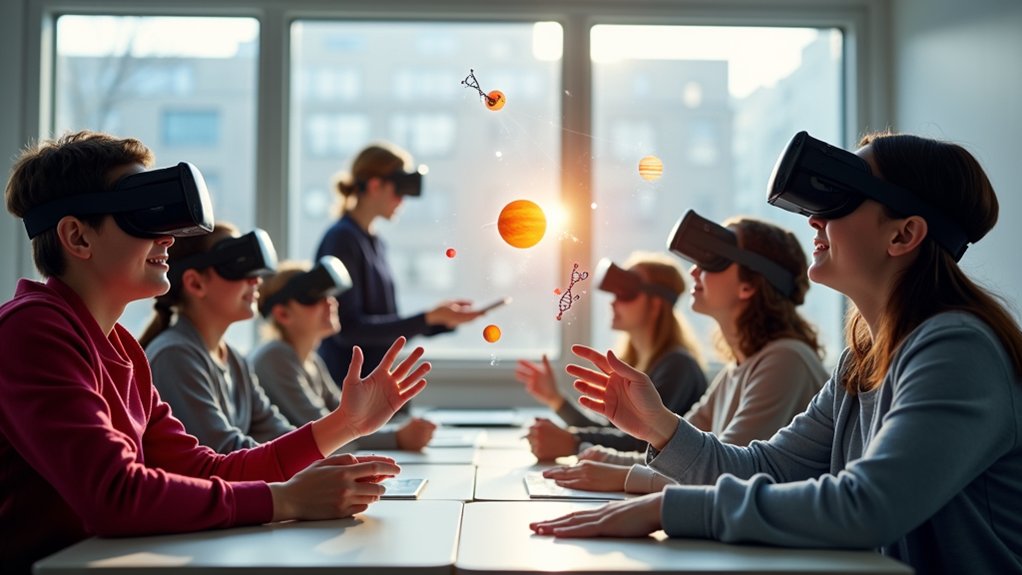
How to complete your crypto transaction?
Start your crypto journey by mastering the first transaction—discover the crucial steps you can't afford to miss before making your move.
Are you curious about transforming education with technology? The metaverse for education opens up a new dimension for learning. Imagine guiding students through virtual classrooms, interactive scenarios, and collaborative projects that surpass traditional methods. By utilizing the metaverse for education, you can boost engagement, foster creativity, and connect learners from around the world in ways never before possible. However, tapping into the full potential of these immersive environments involves understanding both the opportunities and the challenges you’ll face. So, where should you begin your journey into the metaverse for education?

Start by exploring the tools and platforms that best suit your educational goals. Whether you’re using apps, software, or other technology, your approach to the metaverse for education should be strategic and well-informed. As you integrate these innovations, remember to focus on accessibility and inclusivity, ensuring that all students can benefit from this new way of learning.
The term “metaverse” might sound like it belongs in a sci-fi movie, but it’s rapidly becoming a hot topic in discussions about technology and education. The metaverse is essentially a collective virtual space where digital and physical realities merge seamlessly. Within this immersive environment, you can connect with others through avatars, navigate 3D landscapes, and access a wealth of resources.
Grasping these fundamentals of the metaverse helps you understand how this technology is paving the way for innovative learning opportunities.
As the metaverse continues to evolve, its impact on technology, apps, smartphones, and software is undeniable. With the increasing integration of the metaverse into everyday life, it’s essential to stay informed about how this technology will shape future advancements in these fields.
Embracing the metaverse not only enhances our interaction with technology but also opens up new horizons for education and collaboration.
Step into a virtual classroom or campus, and you’ll discover a cutting-edge way to learn, leveraging the power of technology. These platforms aren’t just another video call—they’re immersive environments crafted for interactive and hands-on learning experiences.
With virtual classrooms, you can easily navigate digital lecture halls, attend live lessons, and engage with educational resources in real-time. Virtual campuses often feature libraries, labs, and study spaces, allowing you to explore and interact with content from anywhere in the world.
As technology continues to evolve, virtual classrooms are becoming essential tools in education, providing unprecedented accessibility and innovation. Whether on your smartphone, tablet, or computer, virtual classrooms are redefining how we learn in the digital age.
Immersive environments are revolutionizing the way we collaborate, especially in the realm of technology and apps. By breaking down traditional barriers, these innovative platforms make collaboration more dynamic and engaging.
Imagine gathering with classmates from anywhere in the world, interacting naturally, and brainstorming in real time. Instead of being limited by physical distance or rigid schedules, you can share virtual spaces, use 3D tools, and solve problems together seamlessly.
These immersive environments foster teamwork, making it easier to connect, communicate, and contribute effectively to group projects. Whether you’re using smartphones, software, or the latest apps, immersive environments are at the forefront of transforming how we work and learn in the digital age.
In the ever-evolving world of technology, the metaverse is transforming how we approach interactive learning experiences. Imagine lessons where students can manipulate virtual objects, conduct science experiments, or solve complex math problems, all within immersive 3D spaces.
These interactive learning experiences aren’t just about fun—they offer real-time feedback and instant access to educational resources that significantly boost student engagement.
By incorporating technology into education, we make learning more hands-on and dynamic. This approach not only helps students grasp complex concepts more effectively but also ensures they retain knowledge for longer periods.
With the metaverse, interactive learning experiences are becoming a game-changer in educational technology. So, whether it’s through apps, software, or advanced smartphones, the future of learning is here, and it’s more exciting than ever.
In the ever-evolving world of technology, avatars are emerging as a game-changer for student engagement. Avatars offer a unique way to enhance learning experiences by allowing students to personalize their digital personas. This personalization encourages active participation and self-expression in virtual classrooms.
When students can visually represent themselves through avatars, they feel more connected and confident in sharing ideas. Avatars also play a crucial role in fostering collaboration, breaking down barriers, and making remote interactions more personal and inclusive.
Integrating gamification into lessons can revolutionize the way students engage with technology and learning. By incorporating gamification into your educational approach, you transform traditional lessons into interactive and motivating experiences.
In the metaverse, educators can design quests, challenges, and reward systems that ignite curiosity and promote friendly competition among students. Utilizing badges, leaderboards, and real-time feedback enhances engagement and makes learning through technology both fun and immersive.
This approach not only boosts participation but also helps students retain knowledge more effectively. By embracing gamification in lessons, you create an educational environment that leverages technology to inspire and educate.
Step into the metaverse, where students can connect and collaborate with peers from around the globe in real-time.
This virtual realm offers the chance to engage in virtual exchanges, participate in multicultural projects, and explore global perspectives—all without leaving the classroom.
The metaverse provides an immersive environment to experience different customs, languages, and viewpoints firsthand, breaking down barriers and fostering deeper understanding.
With the metaverse, educators can instantly assess students’ understanding and provide feedback as they learn.
By utilizing technology like interactive quizzes, simulations, and live polls, teachers can gauge comprehension in real time. As students engage with these apps and software, educators can offer targeted suggestions, correct misconceptions, and celebrate achievements immediately.
This instant feedback loop, powered by technology, helps students stay engaged, adjust their learning strategies, and make consistent progress within immersive virtual environments.
Through the use of advanced apps and software, the metaverse transforms the educational experience, making it more interactive and effective.
The metaverse presents exciting opportunities for education, but tackling accessibility and inclusivity challenges is essential to ensure all students can benefit.
To make digital environments accessible, choose platforms with assistive features designed for students with disabilities. Consider the hardware requirements and ensure your technology is compatible with various devices, such as smartphones and computers.
Additionally, address internet access issues and provide multiple language options to avoid excluding any learners. Prioritize user-friendly interfaces and ensure that educational apps and software are intuitive, allowing students from diverse backgrounds, abilities, and resources to fully participate and thrive in the metaverse.
Unlocking the potential of the metaverse in education means adapting both teaching methods and learning strategies to fully utilize this innovative technology.
Embrace the latest in technology, apps, and software to stay ahead. Dedicate time to professional development and encourage students to explore digital tools collaboratively.
Foster critical thinking, creativity, and digital literacy to make the most of the metaverse in education. By preparing yourself and your students, you’ll be ready to thrive in immersive, ever-evolving educational environments shaped by the metaverse.
By embracing the Metaverse for education, you’re opening up a world of dynamic educational possibilities. The Metaverse allows you to create immersive lessons, foster real-time collaboration, and make learning more engaging for everyone. As you explore these virtual environments, you’ll develop new skills and prepare for the future of education. Don’t forget to prioritize accessibility in the Metaverse, ensuring all students have equal opportunities to thrive. Step into the Metaverse and transform the way you and your students learn together. The Metaverse is the future of education, and it’s time to make the most of it.

Start your crypto journey by mastering the first transaction—discover the crucial steps you can't afford to miss before making your move.

How many cryptocurrencies are circulating worldwide today, and what factors are fueling this rapid growth? Discover the surprising answer inside.

Navigating the world of humanoid robot companies isn't easy—discover the seven essential tips you can't afford to overlook before making your choice.

Unlock the secrets of seamless cryptocurrency transactions—understand every crucial step before you risk your first coin. Discover what most beginners miss.

Navigating the vast world of cryptocurrencies, you’ll notice the total number keeps changing—curious what’s causing these endless shifts?

Here are the most secure platforms to buy cryptocurrency online—discover which one keeps your assets safest before you make your next move.